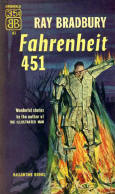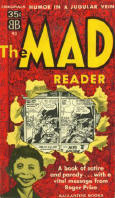
|
Ballantine |
|
|
Click the group of books beginning with number:
Later Numbered Ballantines
|
Ian Ballantine fought many battles in his long career, which proves not that he was just a fighter ... he was also contentious. At Penguin, he constantly pressed owner Allen Lane for more ambitious titles, and especially for better cover art. At Bantam (the second house that Ballantine built), his biggest enemy was the company's Board of Directors. He wanted desperately to raise the cost of the books (which, of course, was not his job), so as to pay better royalties and therefore attract better authors. In 1952, after a relatively small confrontation, (Ballantine had granted a loan to a British subsidiary without their approval) the Board claimed it had finally had enough and fired him. Which left him free to start his own publishing house and put into practice all of the innovations he had fought so long and so hard for. There are no 25¢ Ballantine books. The basic numbered books sold for 35¢, with 50¢ F-series books interspersed numerically. One of his early ideas was the revolutionary concept of publishing a first edition hardcover book simultaneously with the release of a Paperback Original. Next, Ballantine went to the various writers' guilds and unions and told them he would raise royalties to 8% on the hardcovers, and not take ANY publisher's cut of the authors' royalties on the paperbacks (as was the case at most of the other paperback houses), no strings attached. At first, there was a great deal of skepticism. The hardcovers sold for between $1.50 and $3.00, and many were made of pulp pages bound in a sturdy binding with a dust jacket. Most bore the same book number as its corresponding paperback, only with an "H" prefix. For some reason, these are quite collectible today, and fetch very high prices. There are a growing number of them in my database. And there's always an exception. There were evidently some "Student Edition" books sold to schools for 20¢. The one I have a scan for is at the end of the "600" folder. Westerns were still numerous (as they were at Bantam), but they diminished with time. Non-Fiction tended toward WWII books that often told of the horrors of battle from the perspective of fighters on both sides. Science Fiction became a very strong genre, and some books recognized today as true Sci Fi classics (like the Ray Bradbury novel at the top of this page) were Ballantine Paperback Originals. Del Rey, established in 1978, was a label dedicated to Science Fiction and its authors. It had the Ballantine name on the cover, and so I've listed it here. PLEASE NOTE: The BookScans database is not intended to show covers of books printed after 1979. One genre that certainly bears mentioning is Humor. Ballantine, like other houses, published many cartoon books, some of which were slightly irreverent. But an area that had never been touched by book publishers before was the ultra-satirical "Underground Comics." A fledgling comic book, Harvey Kurtzman's MAD, was trying to gain public acceptance of its rendition of this rather crude art form. Ian Ballantine liked to gamble in the game of publishing. He lost a few. But he won this one! ("What, Me Worry?") The first Ballantine MAD book was published before the first MAD Magazine (click HERE). (MAD switched to Signet in the 60's, and then Paperback Library in the 70's, followed by Warner after it was acquired by that company).
Grant Thiessen has a few things to say about Ballantine's numbering system: The various imprints Ballantine
used, like Walden, Comstock, Sierra, etc., and the trade paperbacks all
shared a continuous numbering sequence. they should be interfiled in the
same way that Adult Fantasy series is interfiled with the others, as they
presented no other evidence of having their own numbering sequence.
The Ballantine database was last updated in March, 2022
|
